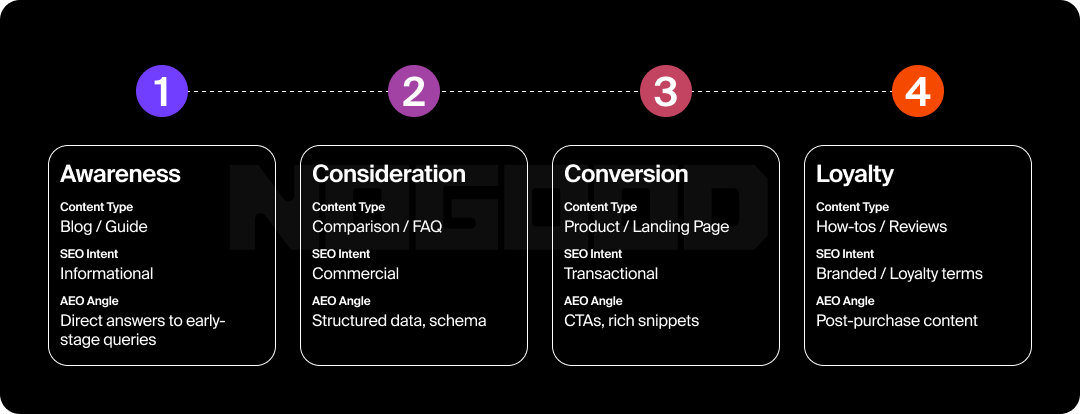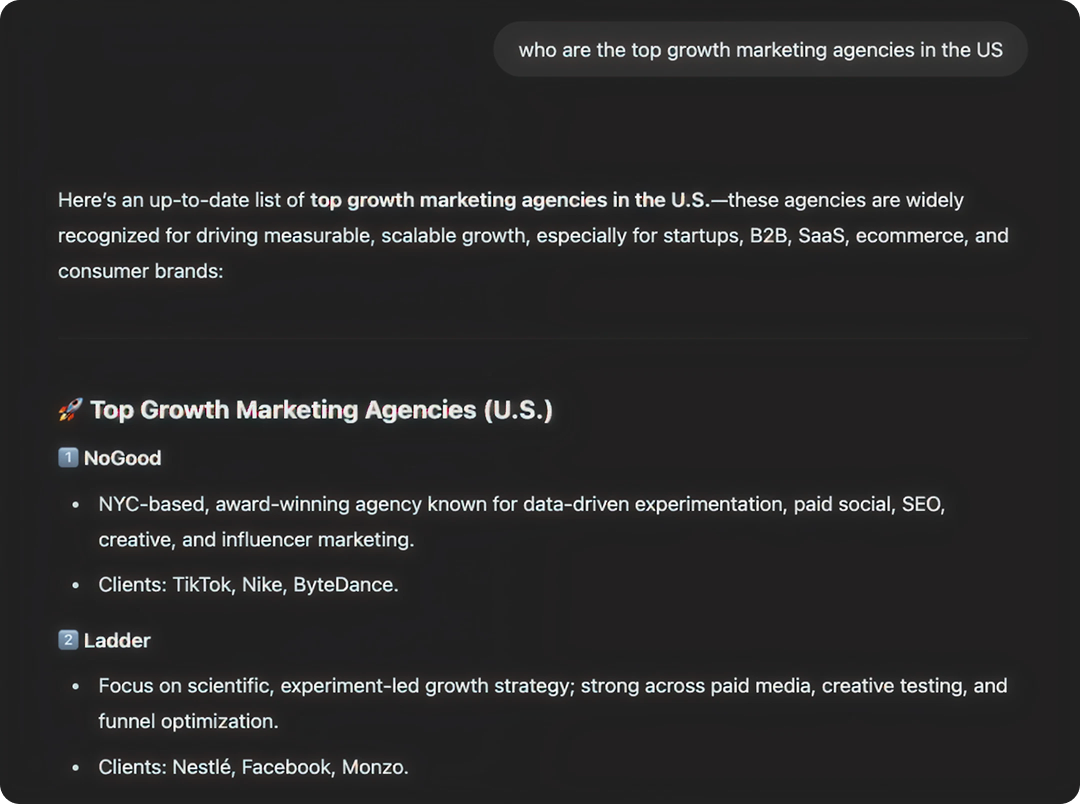Organic search remains one of the most cost-effective channels for driving both new customer acquisition and improving retention rates. With AI answer engines like Google’s AI Overview, ChatGPT, and others rapidly evolving, businesses have unprecedented opportunities to connect with customers—but only if their SEO and AEO strategies are built with customer intent front and center.
In this article, we’ll explore how to align your SEO strategy with the customer journey, dive into the nuances of customer intent, and reveal three actionable ways to sharpen your SEO and AEO efforts.
Why Customer Retention Is Critical for Sustainable Growth
Customer churn is an expensive problem, costing U.S. businesses an estimated $168 billion annually. Yet, focusing on retention could save companies over $35 billion each year by keeping existing customers engaged and satisfied.
Why does retention matter so much? Returning customers not only spend more, but also buy more frequently than new customers, making them invaluable to long-term revenue growth.
In today’s market, brands that prioritize minimizing churn and nurturing loyalty gain a powerful edge. Aligning your SEO and AEO strategies to support customer retention isn’t just smart—it’s essential.
What is Customer-Focused SEO & AEO?
Customer-focused SEO (Search Engine Optimization) and AEO (Answer Engine Optimization) are complementary strategies that help businesses meet their customers exactly where they are in their search journey.
- SEO is the practice of optimizing your website and its content to improve visibility in traditional search engine results pages (SERPs). This includes keyword research, content creation, and technical SEO adjustments—all aimed at matching the searcher’s intent with useful, relevant information.
- AEO targets answer engines and AI platforms such as Google’s AI Overview, ChatGPT, Perplexity, and Claude. Instead of simply ranking web pages, AEO focuses on delivering clear, concise answers that directly resolve user queries, increasing the chances your content is featured in these evolving AI-driven results.
By aligning SEO and AEO efforts around customer intent and behavior, you can drive more qualified traffic, boost engagement, and build lasting loyalty.
Pro Tip: Tools like Goodie integrate predictive analytics to help marketers identify the keywords and content formats that perform best across both SEO and AEO channels, keeping your strategy agile as AI search evolves.
Understanding Customer Intent to Drive Better SEO & AEO Outcomes

Every search query reflects a user’s intent—what they really want to do, or find. Understanding this intent is the cornerstone of both SEO and AEO success.
Here are the four core types of search intent and how they shape your content strategy:
- Navigational Intent: The user is trying to reach a specific website or webpage (i.e. “Facebook login” or “Goodie homepage”)
- Informational Intent: The user is looking to learn about a topic, not buy—yet (i.e. “how to improve SEO,” “what is customer intent,” or “how answer engines work”)
- Transactional Intent: This user is ready to take action—this action could be to make a purchase, sign up, or convert (i.e. “buy Nike shoes online,” “get a free CRM trial,” “best SEO audit tool”)
- Commercial Intent: The user is comparing options before committing (i.e. “best laptops for gaming,” “top SEO tools for agencies,” “Goodie vs. Clearscope”)
Why It Matters
Targeting the right intent leads to better content, higher conversions, and improved visibility across both traditional search and AI-generated results. High-intent keywords (transactional and commercial) often deliver stronger ROI, while informational content builds trust and authority at the top of the funnel.
Aligning SEO & AEO With the Customer Journey

The customer journey doesn’t just end with a click—and neither should your organic search strategy.
To drive real business impact, your SEO and AEO efforts should align with each stage of the customer journey: Awareness, Consideration, Conversion, and Loyalty. Each stage offers a unique opportunity to connect with users by answering their questions, addressing their objections, and guiding them towards a decision.
Awareness Stage: Be Found With Informational Content
At this stage, users are just discovering a need or exploring a problem. Your job? Be helpful.
Strategy:
- Target long-tail, informational keywords
- Answer specific user questions in H2s with direct, concise answers
- Use tools like Gemini, Perplexity, Claude, and ChatGPT to research what questions users are asking
- Create blog posts, guides, and how-tos to introduce topics relevant to your product or service
Example:
If your offering is a SaaS privacy protection tool, a great awareness play could be a blog with the following headline:
H2: How can I protect my personal information while shopping online?
→ Followed by a 1-paragraph direct answer, then further elaboration if needed.
TL;DR—Awareness SEO & AEO Checklist
- Use long-tail, informational keywords
- Answer user questions in H2s with short, direct answers
- Source queries from AI engines to match evolving user behavior
- Create rich, helpful blog content
Consideration Stage: Help Users Compare & Choose
Once users pass the Awareness stage, they move into Consideration (think of this as exploration)—they’re weighing their options. This is where trust-building content shines.
Strategy:
- Target commercial-intent keywords (e.g., “best X for Y: or “X vs. Y”)
- Publish comparison guides, product reviews, and case studies
- Add optimized FAQ sections to product pages
- Include structured data and schema makeup to increase your chances of appearing in AI Overviews and voice search
Example:
Let’s take that same SaaS privacy protection tool—an excellent Consideration-focused piece of content could be:
H1: The 10 Best Privacy Protection Tools in 2025
→ The dating of the article shows recency, and numbered lists often draw user attention. Add your tool in the first spot and find legitimate, comparable examples to list throughout the rest of the article.
TL;DR—Consideration SEO & AEO Checklist
- Create FAQ sections with schema
- Optimize for commercial-intent queries
- Publish comparison and product-focused blog posts
- Answer questions that help users evaluate options
Conversion Stage: Guide Users to Action
In the Conversion stage, users are ready to buy. Your goal here should be to reduce friction and guide them across the finish line.
Strategy:
- Optimize for transactional keywords (e.g., “buy X online,” “get started with X”)
- Create conversion-focused landing pages with strong CTAs
- Feature social proof: user reviews, testimonials, and trust badges
- Use videos, interactive tools, and mobile-optimized pages to support fast and frictionless decision-making
Example:
In our hypothetical example, your SaaS privacy protection tool has an enterprise and a personal option. To cater towards users in the Conversion stage, you could build a landing page with the following hero section:
H1: Enterprise Privacy Protection Software
Button: Claim Your Free Trial Today
→ The remainder of the page should give readers a quick, concise overview of your tool, its features and benefits, and how it compares to other tools on the market. There should be an actionable CTA in most sections, as well as social proof elements throughout.
TL;DR—Conversion SEO Checklist
- Target high-intent transactional keywords
- Build clean, persuasive landing pages
- Add user-generated content for credibility
- Address objections with comparison content and FAQs
- Optimize mobile UX and page speed
Loyalty Stage: Keep Customers Engaged (& Coming Back)
Your job isn’t over after the sale. Customer-focused SEO and AEO strategies should be built to support long-term loyalty, too.
Strategy:
- Create how-to guides, product tutorials, and personalized blog content
- Optimize loyalty or referral program pages with search-friendly terms
- Encourage customers to leave reviews (and display them)
- Add lead capture elements to product pages and checkout flows
Example:
A checkout page pop-up that offers a 10% discount in exchange for the user’s email address helps build a retention funnel while feeding your SEO strategy with user intent data.
TL;DR—Loyalty SEO Checklist
- Personalize post-purchase content
- Optimize for loyalty keywords (e.g., “rewards,” “how to use points”)
- Encourage and display customer reviews
- Use content to re-engage customers and reinforce trust
3 Ways to Make Your SEO & AEO Strategies More Customer-Focused
Once your strategy aligns with the customer journey, the next step is leveling up how you create, structure, and evolve your content. These three tactics will help ensure your SEO and AEO strategies remain deeply aligned with customer needs and competitive in the AI search landscape.
1. Adapt Content for AEO: Be Direct & Digestible
Answer engines like Google’s AI Overview, ChatGPT, and Perplexity are designed to give users concise and immediate answers. To be featured, your content needs to be clear, structured, and scannable.
Customer-Focused Tactics:
- Use H2s and H3s that match user queries exactly (e.g., “what is predictive analytics in SEO”)
- Follow each header with a concise, one-paragraph answer
- Add bullet points, numbered steps, or short FAQs to break up content
- Implement schema markup (especially for product pages, FAQs, and videos)
Why It Matters:
Search is already shifting from “who ranks #1” to “who answers best.” The easier you make it for AI engines to parse your content, the more likely you are to appear in snippets, voice search, or AI-generated results.

2. Leverage Customer Feedback as Content Fuel
Customer feedback doesn’t just improve your product—it also improves your SEO.
How to Use It:
- Feature reviews and testimonials on product and service pages
- Highlight real quotes and pain points in blog content and FAQs
- Use UGC (User-Generated Content) like customer photos to enhance social proof
- Use follow-ups emails or incentives to gather more reviews
Why It Works:
LLMs and AI engines often reference reviews and real user experiences to answer product-related queries. Plus, reviews add fresh, keyword-rich content to your website organically.
SEO Tip:
Highlight phrases from reviews like “easy to use,” “saved time,” or “better than X competitor”. These often match long-tail queries searched by new users in the consideration stage.
3. Use Predictive Data Analytics to Stay Ahead of Customer Needs
Predictive analytics helps you understand what your customers will search for, not just what they searched for last month.
How to Use It:
- Forecast rising search trends before competitors jump on them
- Identify content formats (videos, guides, comparisons) that drive conversions
- Pinpoint drop-off points in the user journey, like cart abandonment or mobile UX issues
- Predict keyword seasonality or intent shifts to time content perfectly
Example:
If searches for “eco-friendly back-to-school supplies” spike every August, a predictive content strategy lets you prep blog posts and product pages now, not after your competitors have already taken the traffic.
SEO & AEO Only Work When They’re Built Around the Customer
Customer-first strategies aren’t just a buzzword—they’re a necessity in an AI search landscape. Today’s users expect fast, direct answers, relevant content, and smooth experiences across every touchpoint. That means your SEO and AEO strategies need to do more than rank—they need to resonate.
By aligning your search strategy with customer intent, using structured data for AEO, and optimizing across the full journey, from Awareness to Loyalty, your brand can show up at the exact right moment with exactly what users need.
The result? Higher visibility, stronger conversions, and deeper customer relationships.
And with tools like Goodie, marketing teams can go even further—using predictive analytics, real-time performance insights, and keyword intent modeling to build strategies that evolve as fast as search itself.
Search is changing. Your strategy should, too.
Make it smarter. Make it faster. Make it customer-focused.
As search engines continue to advance, aligning SEO efforts with customer insights not only enhances the relevance of content but also builds trust and authority within the market. Ultimately, a customer-centric approach to SEO and AEO empowers organizations to create meaningful connections with their audience, driving both traffic and conversions in a way that benefits both the business and its customers.







Excellent points! Integrating SEO with AEO